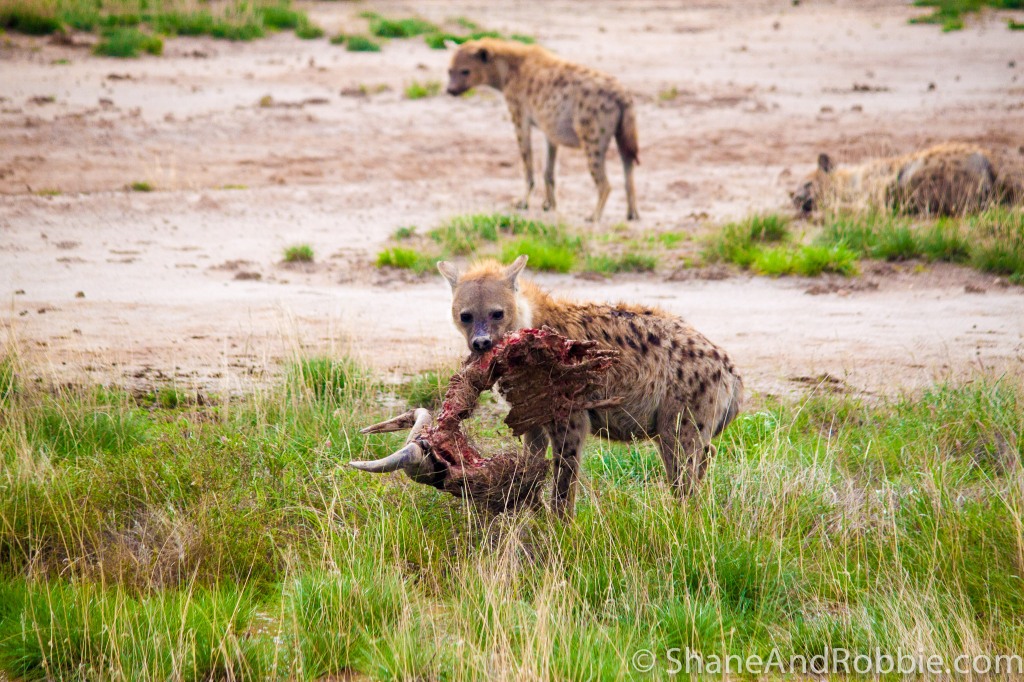Sunrise over Mt Kilimanjaro
Sunrise this morning was just spectacular, and the all-day game drive we went on afterwards even better. We spent more than 8 hours driving through the Amboseli National Park in “safari mode”, “hunting” animals with the binoculars and “shooting” them with our camera. Elephants, hippos, hyenas, gazelles, giraffe, buffalo, zebra, wildebeest…. so many animals!
The animal we saw the most of was elephants – it was great! The increase in elephant numbers since the global ban on ivory trading in January 1990 has been fantastic. Elephants are really cool to watch – their intelligence is obvious* and their sheer size makes them impressive (African elephants can reach a height of 4m at the shoulder and weigh up to 7 tons). We saw lots of families of elephants moving through the bush, feasting on the fresh green grass and bathing in the mud pools (a coating of mud helps protect their skin from the sun and also keeps many of the bitey insects away). Elephants herds are led by a matriarch, usually the oldest cow, with up to 30 other females and calves. The baby elephants were so cute, even if they do weigh over 100kgs (we learnt that baby elephants are about 85cm tall and weigh around 120kg when they are born)!
*Elephant intelligence is comparable to that of primates. Due to their brain power and trainability elephants have been used as work animals, instruments of war and circus performers for centuries.
We also got to see lots of hippos wallowing in the pools and even wandering around along the shores of Amboseli’s many small lakes munching on grasses. The hippopotamus really is a huge animal – they weigh up to 3 tons! With their barrel-shaped torsos, enormous mouths and teeth, nearly hairless bodies, stubby legs and tremendous size, hippos look quite awkward and cumersome. Don’t let that fool you though – hippos can easily outrun a human (hippos have been clocked at 30km/hour) and they are one of the most aggressive creatures on the plains, which actually makes hippos one of the most dangerous animals in Africa! Viewed from a (safe) distance, however, they are pretty cool.
The other highlight of the day was seeing a clan of spotted hyenas tearing into the remnants of a wildebeest. Hyenas are omnivorous and are happy to dine on both fresh and not-so-fresh meat – they are pack hunters and famed scavengers, happy to dine on the leftovers from other predators. With their sloping backs, long front legs and awkward running gait, hyenas have a distinctive profile and make some truly terrifying sounds – they yip, laugh and cackle like no other animal in Africa. Not that the clan of hyenas we saw were making much noise – they were all too full after feasting and were just lying around in the sun with their full bellies pointing skywards! Once they had all had their fill the only action we saw was when one of the hyenas get up, walked over to the last piece of the wildebeest and picked it up. She carried the skull and spinal column across the road, right in front of us, and then set about crunching through the vertebrae to get at the last bits of juicy flesh. As the photos below show, it was pretty grizzly, but totally mesmerising.
We even got to have a picnic lunch up on top of a hill*, watching all the animals on the plains below us going about their business. The view was amazing – green grassy plains, wetlands dotted with elephants and hippos and flocks of birds making the most of the late rains. A great place for a picnic!
*Good visibility is a must if you’re going to hop out of the vehicle when on safari – we certainly didn’t want any animals sneaking up on us whilst we were busy enjoying our sandwiches!
Around 5:30pm we made our way back to camp, tired but very happy after our the day of driving and animal spotting. The views along the way were great – the scenery here is breathtaking. Today was actually our last full day in Kenya (tomorrow we cross the border into Tanzania), which is a little bitter-sweet as we’ve had a great time these last 10 days here. Still, Tanzania will no doubt be a whole new adventure of its own!
Categories: Kenya















